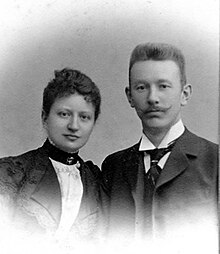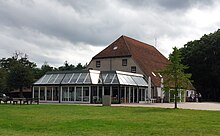Mariahoeve (Leende)
Mariahoeve ( German Marienhof ) is an estate between Leende and Maarheeze in the Netherlands and extends over approximately 250 hectares .
history
The Zevenhuizense Heide, originally a heather and stiff sand area with some bog lakes, was bought by the Amsterdam merchant Josef Laimböck during the First World War. Laimböck was a glove dealer from Stumm in the Zillertal ( Tyrol , Austria ). He made his fortune with leather goods shops in Amsterdam , Rotterdam , The Hague , Haarlem and Utrecht . On September 30, 1918, he received planning permission for a farm on the 225 hectare estate. The Marienhof was built as a support farm and was named after Josef's wife Maria Terkatz from Elberfeld (today's Wuppertal ). According to the Leende population register, Josef, Maria, their son Franz and the servant Anna Baudoin lived on Mariahoeve from early 1921 to mid-1922. Joseph Laimböck's son Franz helped his father plant American oaks on both sides of the long driveway. Mixed farming was used on the poor soil and rye, oats and potatoes were grown. The farm proved to be no longer profitable in the 30s of the 20th century. A major reason was that cheap grain from the United States was entering the European market during this period. The area was acquired in 1938 as an investment property from the Noord-Hollandsche levensverzekeringsmaatschappij in Alkmaar (also known as Hooge Huys Levensverzekeringen van 1891 NV ) for 65,000 guilders , which planted conifers there and leased it as a hunting area. This is how today's area was created, in which some parcels are still reminiscent of the earlier agricultural activity.
Later, some larger ponds were created because sand was dug up for the construction of the N2 road.
In 1976 the golf course of the Leender Golf Club Haviksoord was opened on part of the site . The remaining part came into the hands of Anna Gertrude Hofstee (1914-2003) in 1989 as a foundation registered by a high judge ( Stichting Buur-Hofstee / Mariahoeve ). Anna Gertrude was the granddaughter of the founder of the Noord-Hollandsche levensverzekeringsmaatschappij , Jan Hofstee. She was married to Nico Buur (1914–1988), who was the secretary of the aforementioned insurance company, and she was closely involved in his work at the Nationale Vereniging de Zonnebloem , an association that campaigned for the disabled.
The estate is open to people with a physical handicap who need relaxation through the local department of De Zonnebloem . A paved walkway suitable for wheelchair users leads through the estate, which is not open to the public.
The insurance company was taken over by NV Bouwfonds Nederlandse Gemeenten in 1984 and became part of Reaal in 1996 .
nature
Most of the estate consists of dry coniferous forest, through which there are avenues that are planted with American red oaks. There are also pastures, wild fields, remnants of heather and moor lakes. The softwood, mainly black pine , Scots pine and spruce , was initially used as pit wood and is currently felled as a material for the production of panels. Red deer , fallow deer and roe deer live in this area . There is also a bat cellar in which, among other things, the brown long-eared animal lives. The insect world includes the blue-winged wasteland insect , the field cricket and the small mother-of-pearl butterfly . In the natural moor lakes, which are currently being renatured, you can find bankweed and stalked duckweed, respectively. Glass water lenses. Mountain newts , little rushes and little mosses live in and around the moor lakes . The moor lakes are also rich in water birds.
Web links
- Official website (Dutch)
- Website of the Dr. Hofstee Foundation (Dutch)
Individual evidence
- ↑ Herbert Buzas: How do the vegetables get into the Kalverstraat , Tiroler Tageszeitung No. 59, March 11, 1950, page 5
- ↑ Peer van Lind: Leven en folklore onder de Leendse toren: Josef Laimböck en de Mariahoeve , Weekblad Parel van Brabant, Volume 47, No. 2, October 15, 2008, page 18
- ↑ BR-Leende-15293-2506 Index of the Leende population register 1921-1931, Folio 125
- ^ JJ Schildstra, ons landelijk eigendom, sea dan een belegging alleen , Alkmaar 23 June 1986, pages 54–57
Coordinates: 51 ° 20 ′ 2.6 ″ N , 5 ° 35 ′ 30.1 ″ E




